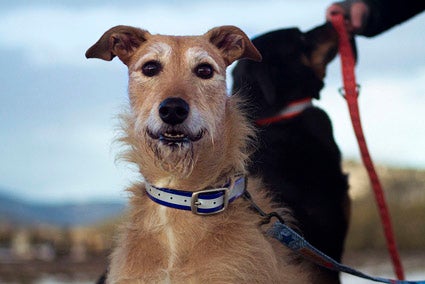Does Your Dog Lunge on Walks? Tips for Controlling this Behavior

When you take your dog for a walk does he walk calmly beside you or does he pull at the leash, lunging at everything that passes by? Lunging on the leash is a very common behavior for dogs but it is not a positive one. Dog that have trouble with this type of behavior are usually called leash-reactive dogs and with some time and effort you can learn to control this behavior.
Working with Your Dog at Home
Before you can teach your dog to stop lunging on the leash, there are some exercises you should try at home. The first thing you need to do is teach your dog to respond to your commands, giving you his attention when you say his name. Even if your dog has basic obedience training and responds to commands like “Sit” or “Stay” he may not be consistent about looking at you when you say his name. This is a very important thing for him to learn because it can help you gain control in a dangerous situation or you can use it to distract your dog from an undesired behavior. All you have to do is work with him by saying his name and rewarding him for looking at you. Start in a quiet location and then move to busier, more distracting environments to reinforce the response.
Reducing Your Dog’s Lunging Behavior
Once your dog has learned to look at you when you say his name you can start working with him to reduce his lunging behavior. Start by taking your dog for a walk and keep an eye out for other dogs, people, or whatever causes your dog to lunge on the leash. As soon as your dog notices one of these things, say his name to get his attention and immediately reward him when he gives it to you. After rewarding your dog, you can move a little closer then repeat and reward. If your dog resumes his old behavior, baking and lunging, it is probably because you moved forward too quickly. Go back a step and work with your dog a little more before progressing to the next step.
Something else you can try to manage your dog’s lunging behavior is to teach him to heel on the leash – to walk calmly next to you instead of running ahead. Start by standing with your dog on your left side and tell him to Sit and Stay – you should also keep some treats in your left hand. Tell your dog to heel then hold a treat in front of his nose and start walking forward quickly. Ideally, your dog should follow along with you in pursuit of the treat. When you are ready to stop, tell your dog to Sit and, when he does, give him the treat. Keep working with your dog using this training sequence and working your way up to longer periods of walking – if your dog gets distracted, say his name and wave the treat in front of his nose to bring him back on track. Eventually you can try this sequence in an outdoor setting and on walks.
Letting your dog lunge at other dogs and people is irresponsible behavior on your part as a dog owner. You cannot assume that other dogs will be friendly and your dog could end up in a very dangerous situation. Do yourself and your dog a favor by nipping lunging behavior in the bud using some of the tips and tricks suggested above.
Photo credit: Kevin Beaty/Flickr
Please consult the services of a Professional Dog Trainer, Behaviorist or Veterinarian before implementing any of the advice contained on this site.






